Cadbury Case Study: Product/Service Development and Strategies
VerifiedAdded on 2024/06/11
|25
|6121
|148
Report
AI Summary
This report provides a comprehensive analysis of product and service development, focusing on Cadbury as a case study. It explains the procedures involved in product and service development, highlighting the level of consumer integration. The report applies the product development process to Cadbury's new product idea, a dairy milk chocolate with peanut butter and fruit and nut. Furthermore, it assesses the life cycle stage of products in Cadbury's portfolio and evaluates the product line management choices needed for individual products. Finally, it includes a reflective statement critically reflecting on teamwork, creative development, and presentation, offering a holistic view of the product development journey within Cadbury.

PRODUCT AND SERVICE
DEVELOPMENT
Cadbury
DEVELOPMENT
Cadbury
Paraphrase This Document
Need a fresh take? Get an instant paraphrase of this document with our AI Paraphraser
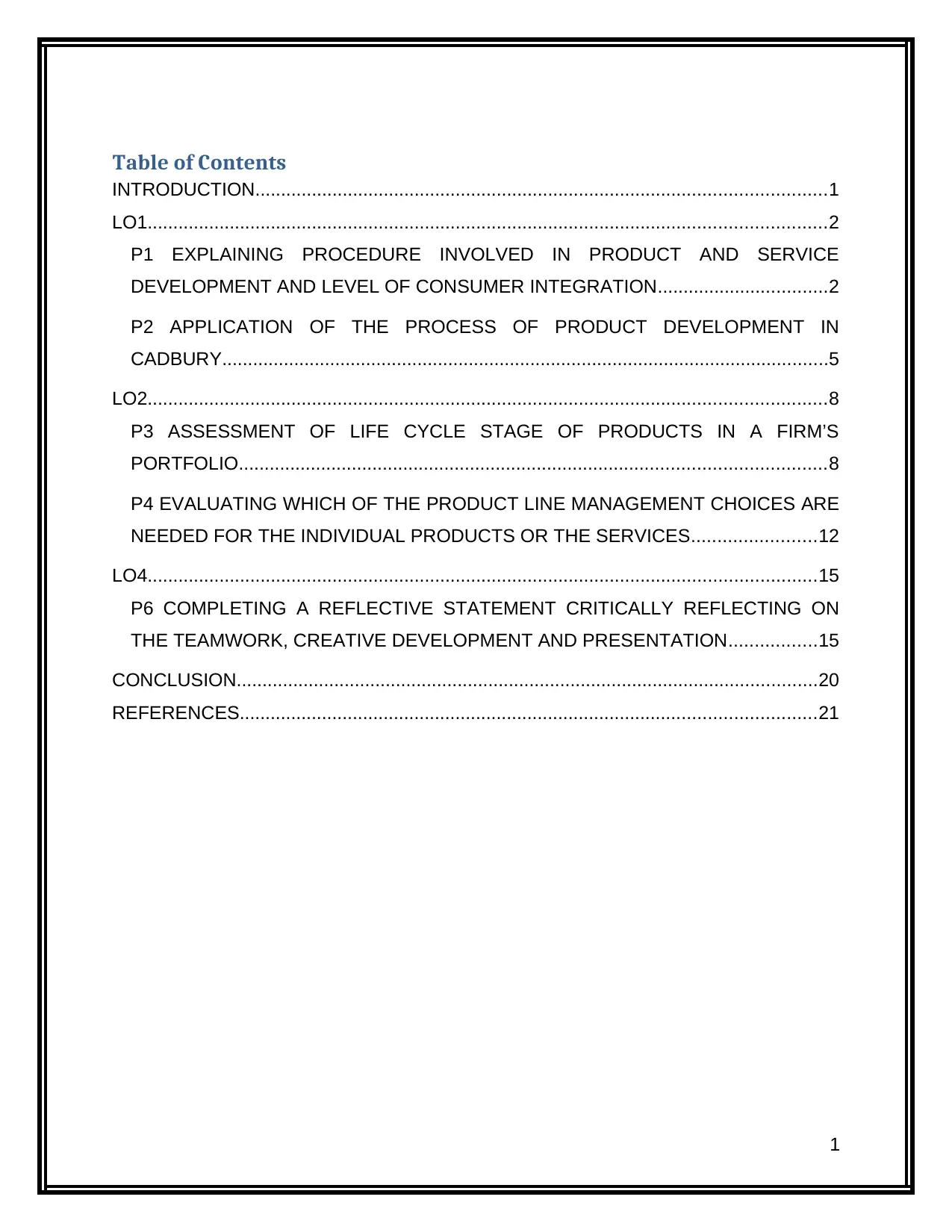
Table of Contents
INTRODUCTION...............................................................................................................1
LO1....................................................................................................................................2
P1 EXPLAINING PROCEDURE INVOLVED IN PRODUCT AND SERVICE
DEVELOPMENT AND LEVEL OF CONSUMER INTEGRATION.................................2
P2 APPLICATION OF THE PROCESS OF PRODUCT DEVELOPMENT IN
CADBURY......................................................................................................................5
LO2....................................................................................................................................8
P3 ASSESSMENT OF LIFE CYCLE STAGE OF PRODUCTS IN A FIRM’S
PORTFOLIO..................................................................................................................8
P4 EVALUATING WHICH OF THE PRODUCT LINE MANAGEMENT CHOICES ARE
NEEDED FOR THE INDIVIDUAL PRODUCTS OR THE SERVICES........................12
LO4..................................................................................................................................15
P6 COMPLETING A REFLECTIVE STATEMENT CRITICALLY REFLECTING ON
THE TEAMWORK, CREATIVE DEVELOPMENT AND PRESENTATION.................15
CONCLUSION.................................................................................................................20
REFERENCES................................................................................................................21
1
INTRODUCTION...............................................................................................................1
LO1....................................................................................................................................2
P1 EXPLAINING PROCEDURE INVOLVED IN PRODUCT AND SERVICE
DEVELOPMENT AND LEVEL OF CONSUMER INTEGRATION.................................2
P2 APPLICATION OF THE PROCESS OF PRODUCT DEVELOPMENT IN
CADBURY......................................................................................................................5
LO2....................................................................................................................................8
P3 ASSESSMENT OF LIFE CYCLE STAGE OF PRODUCTS IN A FIRM’S
PORTFOLIO..................................................................................................................8
P4 EVALUATING WHICH OF THE PRODUCT LINE MANAGEMENT CHOICES ARE
NEEDED FOR THE INDIVIDUAL PRODUCTS OR THE SERVICES........................12
LO4..................................................................................................................................15
P6 COMPLETING A REFLECTIVE STATEMENT CRITICALLY REFLECTING ON
THE TEAMWORK, CREATIVE DEVELOPMENT AND PRESENTATION.................15
CONCLUSION.................................................................................................................20
REFERENCES................................................................................................................21
1
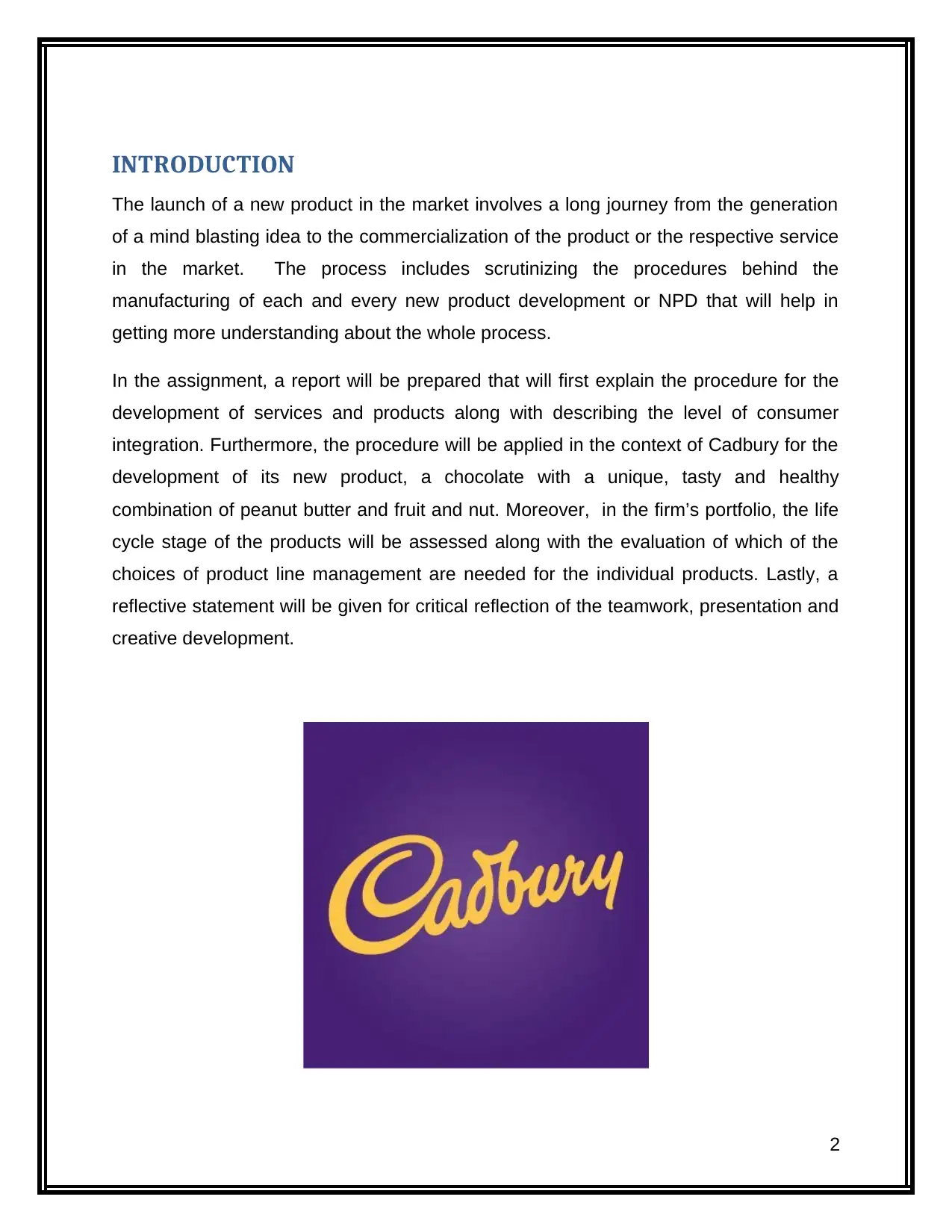
INTRODUCTION
The launch of a new product in the market involves a long journey from the generation
of a mind blasting idea to the commercialization of the product or the respective service
in the market. The process includes scrutinizing the procedures behind the
manufacturing of each and every new product development or NPD that will help in
getting more understanding about the whole process.
In the assignment, a report will be prepared that will first explain the procedure for the
development of services and products along with describing the level of consumer
integration. Furthermore, the procedure will be applied in the context of Cadbury for the
development of its new product, a chocolate with a unique, tasty and healthy
combination of peanut butter and fruit and nut. Moreover, in the firm’s portfolio, the life
cycle stage of the products will be assessed along with the evaluation of which of the
choices of product line management are needed for the individual products. Lastly, a
reflective statement will be given for critical reflection of the teamwork, presentation and
creative development.
2
The launch of a new product in the market involves a long journey from the generation
of a mind blasting idea to the commercialization of the product or the respective service
in the market. The process includes scrutinizing the procedures behind the
manufacturing of each and every new product development or NPD that will help in
getting more understanding about the whole process.
In the assignment, a report will be prepared that will first explain the procedure for the
development of services and products along with describing the level of consumer
integration. Furthermore, the procedure will be applied in the context of Cadbury for the
development of its new product, a chocolate with a unique, tasty and healthy
combination of peanut butter and fruit and nut. Moreover, in the firm’s portfolio, the life
cycle stage of the products will be assessed along with the evaluation of which of the
choices of product line management are needed for the individual products. Lastly, a
reflective statement will be given for critical reflection of the teamwork, presentation and
creative development.
2
⊘ This is a preview!⊘
Do you want full access?
Subscribe today to unlock all pages.

Trusted by 1+ million students worldwide
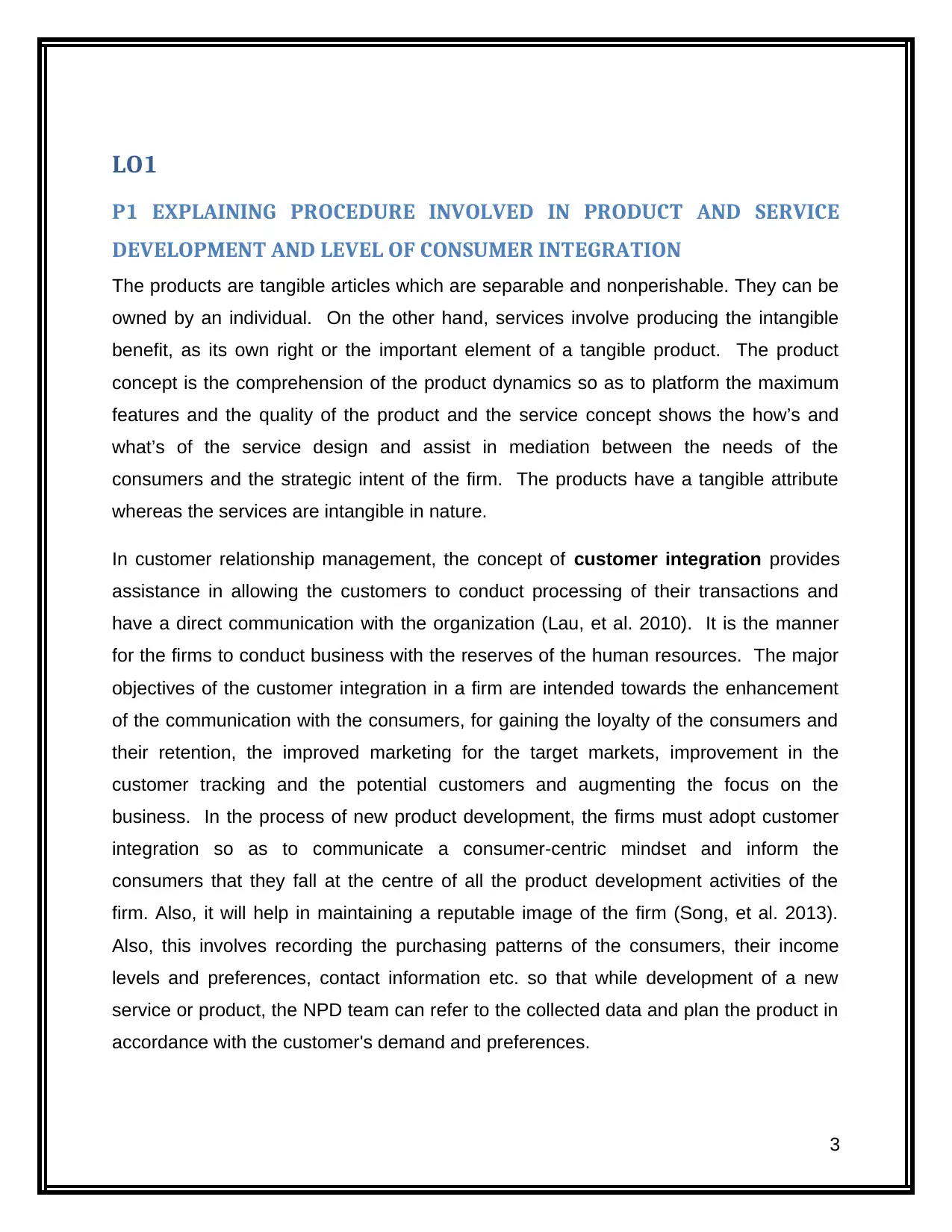
LO1
P1 EXPLAINING PROCEDURE INVOLVED IN PRODUCT AND SERVICE
DEVELOPMENT AND LEVEL OF CONSUMER INTEGRATION
The products are tangible articles which are separable and nonperishable. They can be
owned by an individual. On the other hand, services involve producing the intangible
benefit, as its own right or the important element of a tangible product. The product
concept is the comprehension of the product dynamics so as to platform the maximum
features and the quality of the product and the service concept shows the how’s and
what’s of the service design and assist in mediation between the needs of the
consumers and the strategic intent of the firm. The products have a tangible attribute
whereas the services are intangible in nature.
In customer relationship management, the concept of customer integration provides
assistance in allowing the customers to conduct processing of their transactions and
have a direct communication with the organization (Lau, et al. 2010). It is the manner
for the firms to conduct business with the reserves of the human resources. The major
objectives of the customer integration in a firm are intended towards the enhancement
of the communication with the consumers, for gaining the loyalty of the consumers and
their retention, the improved marketing for the target markets, improvement in the
customer tracking and the potential customers and augmenting the focus on the
business. In the process of new product development, the firms must adopt customer
integration so as to communicate a consumer-centric mindset and inform the
consumers that they fall at the centre of all the product development activities of the
firm. Also, it will help in maintaining a reputable image of the firm (Song, et al. 2013).
Also, this involves recording the purchasing patterns of the consumers, their income
levels and preferences, contact information etc. so that while development of a new
service or product, the NPD team can refer to the collected data and plan the product in
accordance with the customer's demand and preferences.
3
P1 EXPLAINING PROCEDURE INVOLVED IN PRODUCT AND SERVICE
DEVELOPMENT AND LEVEL OF CONSUMER INTEGRATION
The products are tangible articles which are separable and nonperishable. They can be
owned by an individual. On the other hand, services involve producing the intangible
benefit, as its own right or the important element of a tangible product. The product
concept is the comprehension of the product dynamics so as to platform the maximum
features and the quality of the product and the service concept shows the how’s and
what’s of the service design and assist in mediation between the needs of the
consumers and the strategic intent of the firm. The products have a tangible attribute
whereas the services are intangible in nature.
In customer relationship management, the concept of customer integration provides
assistance in allowing the customers to conduct processing of their transactions and
have a direct communication with the organization (Lau, et al. 2010). It is the manner
for the firms to conduct business with the reserves of the human resources. The major
objectives of the customer integration in a firm are intended towards the enhancement
of the communication with the consumers, for gaining the loyalty of the consumers and
their retention, the improved marketing for the target markets, improvement in the
customer tracking and the potential customers and augmenting the focus on the
business. In the process of new product development, the firms must adopt customer
integration so as to communicate a consumer-centric mindset and inform the
consumers that they fall at the centre of all the product development activities of the
firm. Also, it will help in maintaining a reputable image of the firm (Song, et al. 2013).
Also, this involves recording the purchasing patterns of the consumers, their income
levels and preferences, contact information etc. so that while development of a new
service or product, the NPD team can refer to the collected data and plan the product in
accordance with the customer's demand and preferences.
3
Paraphrase This Document
Need a fresh take? Get an instant paraphrase of this document with our AI Paraphraser
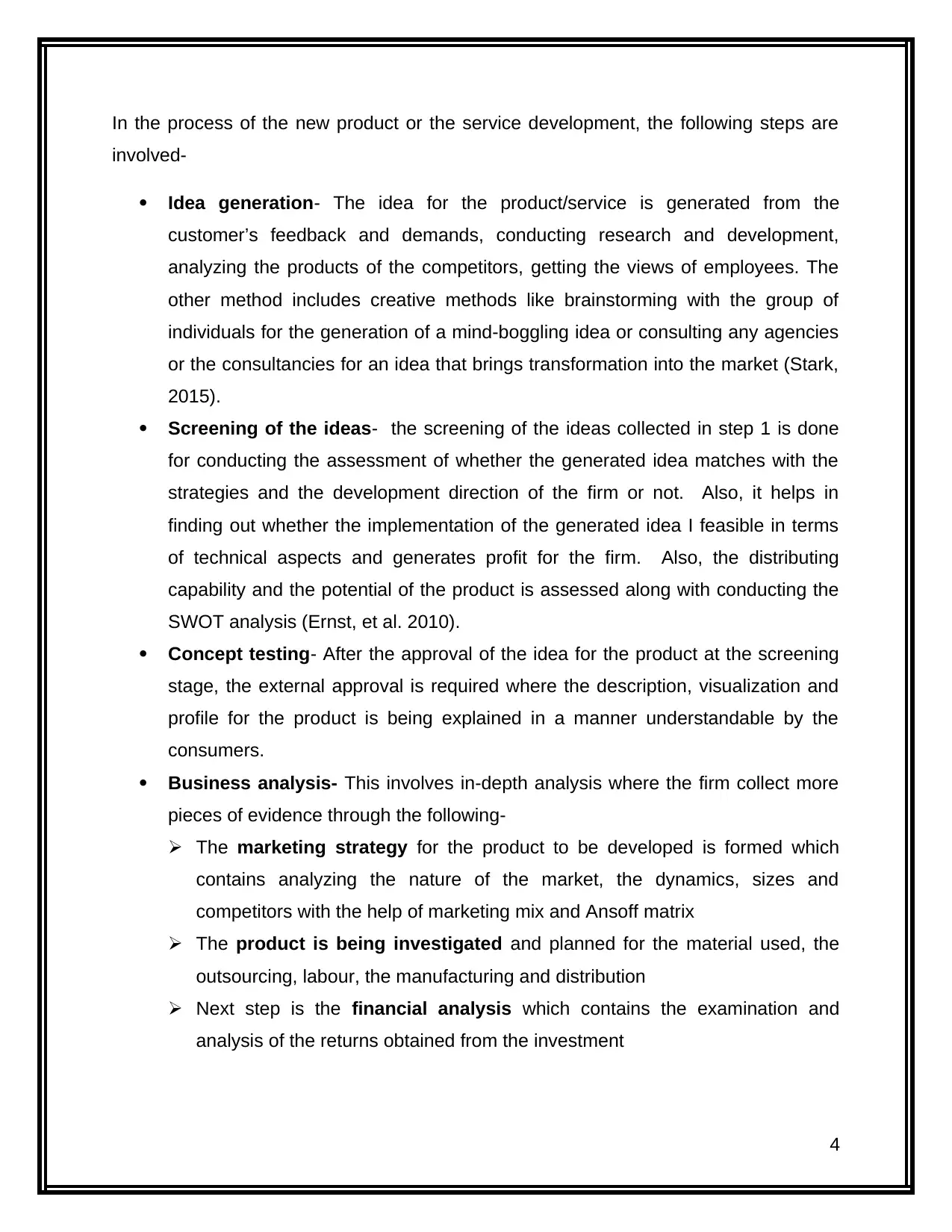
In the process of the new product or the service development, the following steps are
involved-
Idea generation- The idea for the product/service is generated from the
customer’s feedback and demands, conducting research and development,
analyzing the products of the competitors, getting the views of employees. The
other method includes creative methods like brainstorming with the group of
individuals for the generation of a mind-boggling idea or consulting any agencies
or the consultancies for an idea that brings transformation into the market (Stark,
2015).
Screening of the ideas- the screening of the ideas collected in step 1 is done
for conducting the assessment of whether the generated idea matches with the
strategies and the development direction of the firm or not. Also, it helps in
finding out whether the implementation of the generated idea I feasible in terms
of technical aspects and generates profit for the firm. Also, the distributing
capability and the potential of the product is assessed along with conducting the
SWOT analysis (Ernst, et al. 2010).
Concept testing- After the approval of the idea for the product at the screening
stage, the external approval is required where the description, visualization and
profile for the product is being explained in a manner understandable by the
consumers.
Business analysis- This involves in-depth analysis where the firm collect more
pieces of evidence through the following-
The marketing strategy for the product to be developed is formed which
contains analyzing the nature of the market, the dynamics, sizes and
competitors with the help of marketing mix and Ansoff matrix
The product is being investigated and planned for the material used, the
outsourcing, labour, the manufacturing and distribution
Next step is the financial analysis which contains the examination and
analysis of the returns obtained from the investment
4
involved-
Idea generation- The idea for the product/service is generated from the
customer’s feedback and demands, conducting research and development,
analyzing the products of the competitors, getting the views of employees. The
other method includes creative methods like brainstorming with the group of
individuals for the generation of a mind-boggling idea or consulting any agencies
or the consultancies for an idea that brings transformation into the market (Stark,
2015).
Screening of the ideas- the screening of the ideas collected in step 1 is done
for conducting the assessment of whether the generated idea matches with the
strategies and the development direction of the firm or not. Also, it helps in
finding out whether the implementation of the generated idea I feasible in terms
of technical aspects and generates profit for the firm. Also, the distributing
capability and the potential of the product is assessed along with conducting the
SWOT analysis (Ernst, et al. 2010).
Concept testing- After the approval of the idea for the product at the screening
stage, the external approval is required where the description, visualization and
profile for the product is being explained in a manner understandable by the
consumers.
Business analysis- This involves in-depth analysis where the firm collect more
pieces of evidence through the following-
The marketing strategy for the product to be developed is formed which
contains analyzing the nature of the market, the dynamics, sizes and
competitors with the help of marketing mix and Ansoff matrix
The product is being investigated and planned for the material used, the
outsourcing, labour, the manufacturing and distribution
Next step is the financial analysis which contains the examination and
analysis of the returns obtained from the investment
4
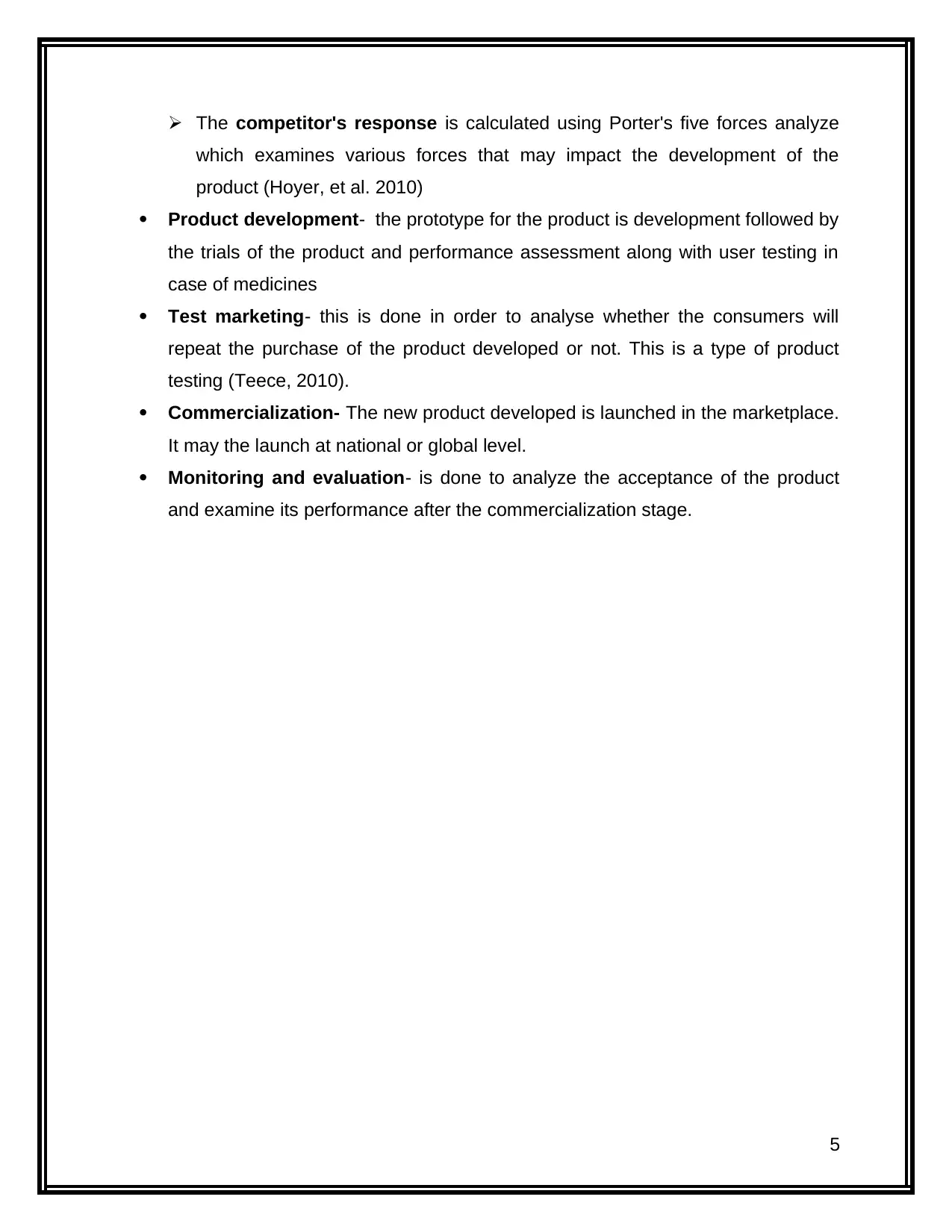
The competitor's response is calculated using Porter's five forces analyze
which examines various forces that may impact the development of the
product (Hoyer, et al. 2010)
Product development- the prototype for the product is development followed by
the trials of the product and performance assessment along with user testing in
case of medicines
Test marketing- this is done in order to analyse whether the consumers will
repeat the purchase of the product developed or not. This is a type of product
testing (Teece, 2010).
Commercialization- The new product developed is launched in the marketplace.
It may the launch at national or global level.
Monitoring and evaluation- is done to analyze the acceptance of the product
and examine its performance after the commercialization stage.
5
which examines various forces that may impact the development of the
product (Hoyer, et al. 2010)
Product development- the prototype for the product is development followed by
the trials of the product and performance assessment along with user testing in
case of medicines
Test marketing- this is done in order to analyse whether the consumers will
repeat the purchase of the product developed or not. This is a type of product
testing (Teece, 2010).
Commercialization- The new product developed is launched in the marketplace.
It may the launch at national or global level.
Monitoring and evaluation- is done to analyze the acceptance of the product
and examine its performance after the commercialization stage.
5
⊘ This is a preview!⊘
Do you want full access?
Subscribe today to unlock all pages.

Trusted by 1+ million students worldwide
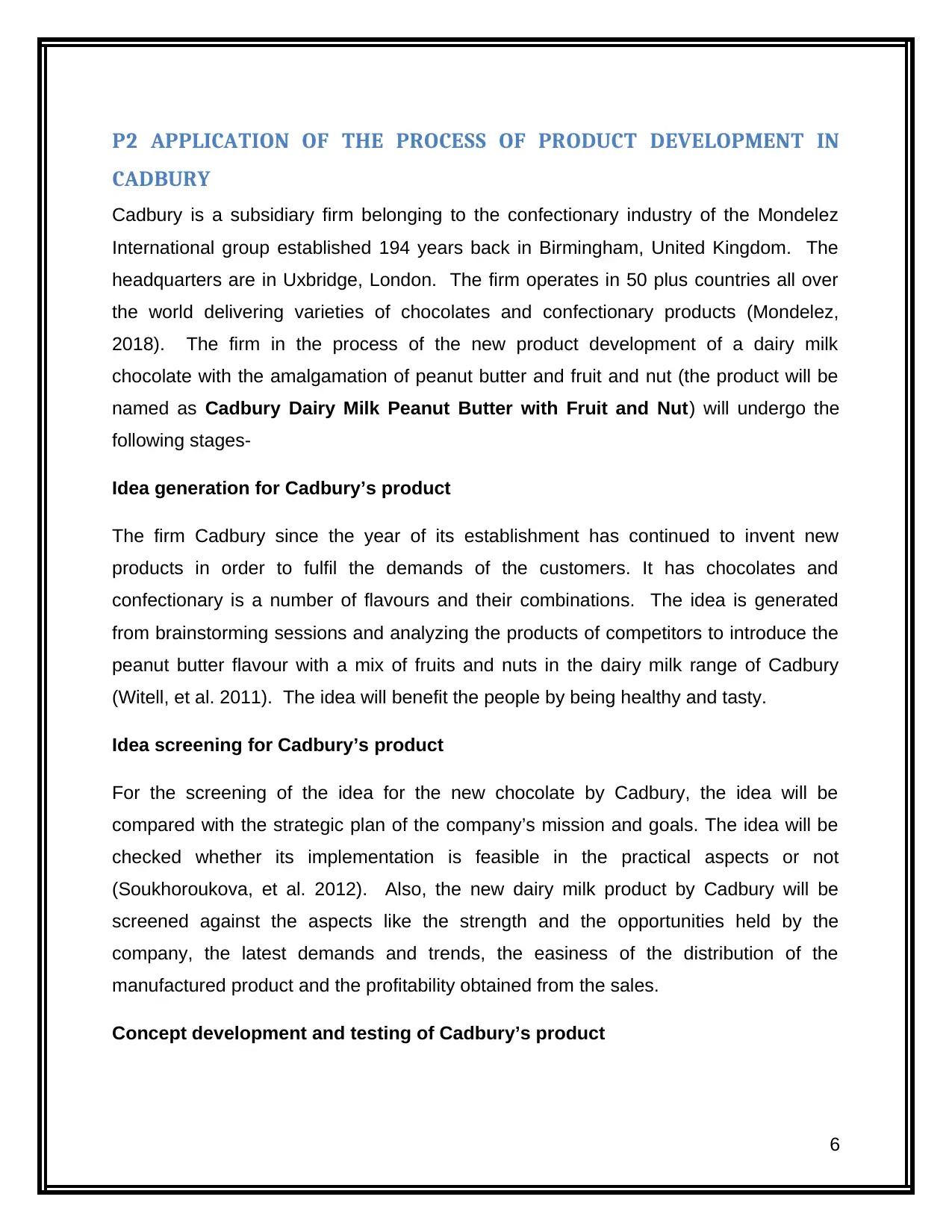
P2 APPLICATION OF THE PROCESS OF PRODUCT DEVELOPMENT IN
CADBURY
Cadbury is a subsidiary firm belonging to the confectionary industry of the Mondelez
International group established 194 years back in Birmingham, United Kingdom. The
headquarters are in Uxbridge, London. The firm operates in 50 plus countries all over
the world delivering varieties of chocolates and confectionary products (Mondelez,
2018). The firm in the process of the new product development of a dairy milk
chocolate with the amalgamation of peanut butter and fruit and nut (the product will be
named as Cadbury Dairy Milk Peanut Butter with Fruit and Nut) will undergo the
following stages-
Idea generation for Cadbury’s product
The firm Cadbury since the year of its establishment has continued to invent new
products in order to fulfil the demands of the customers. It has chocolates and
confectionary is a number of flavours and their combinations. The idea is generated
from brainstorming sessions and analyzing the products of competitors to introduce the
peanut butter flavour with a mix of fruits and nuts in the dairy milk range of Cadbury
(Witell, et al. 2011). The idea will benefit the people by being healthy and tasty.
Idea screening for Cadbury’s product
For the screening of the idea for the new chocolate by Cadbury, the idea will be
compared with the strategic plan of the company’s mission and goals. The idea will be
checked whether its implementation is feasible in the practical aspects or not
(Soukhoroukova, et al. 2012). Also, the new dairy milk product by Cadbury will be
screened against the aspects like the strength and the opportunities held by the
company, the latest demands and trends, the easiness of the distribution of the
manufactured product and the profitability obtained from the sales.
Concept development and testing of Cadbury’s product
6
CADBURY
Cadbury is a subsidiary firm belonging to the confectionary industry of the Mondelez
International group established 194 years back in Birmingham, United Kingdom. The
headquarters are in Uxbridge, London. The firm operates in 50 plus countries all over
the world delivering varieties of chocolates and confectionary products (Mondelez,
2018). The firm in the process of the new product development of a dairy milk
chocolate with the amalgamation of peanut butter and fruit and nut (the product will be
named as Cadbury Dairy Milk Peanut Butter with Fruit and Nut) will undergo the
following stages-
Idea generation for Cadbury’s product
The firm Cadbury since the year of its establishment has continued to invent new
products in order to fulfil the demands of the customers. It has chocolates and
confectionary is a number of flavours and their combinations. The idea is generated
from brainstorming sessions and analyzing the products of competitors to introduce the
peanut butter flavour with a mix of fruits and nuts in the dairy milk range of Cadbury
(Witell, et al. 2011). The idea will benefit the people by being healthy and tasty.
Idea screening for Cadbury’s product
For the screening of the idea for the new chocolate by Cadbury, the idea will be
compared with the strategic plan of the company’s mission and goals. The idea will be
checked whether its implementation is feasible in the practical aspects or not
(Soukhoroukova, et al. 2012). Also, the new dairy milk product by Cadbury will be
screened against the aspects like the strength and the opportunities held by the
company, the latest demands and trends, the easiness of the distribution of the
manufactured product and the profitability obtained from the sales.
Concept development and testing of Cadbury’s product
6
Paraphrase This Document
Need a fresh take? Get an instant paraphrase of this document with our AI Paraphraser
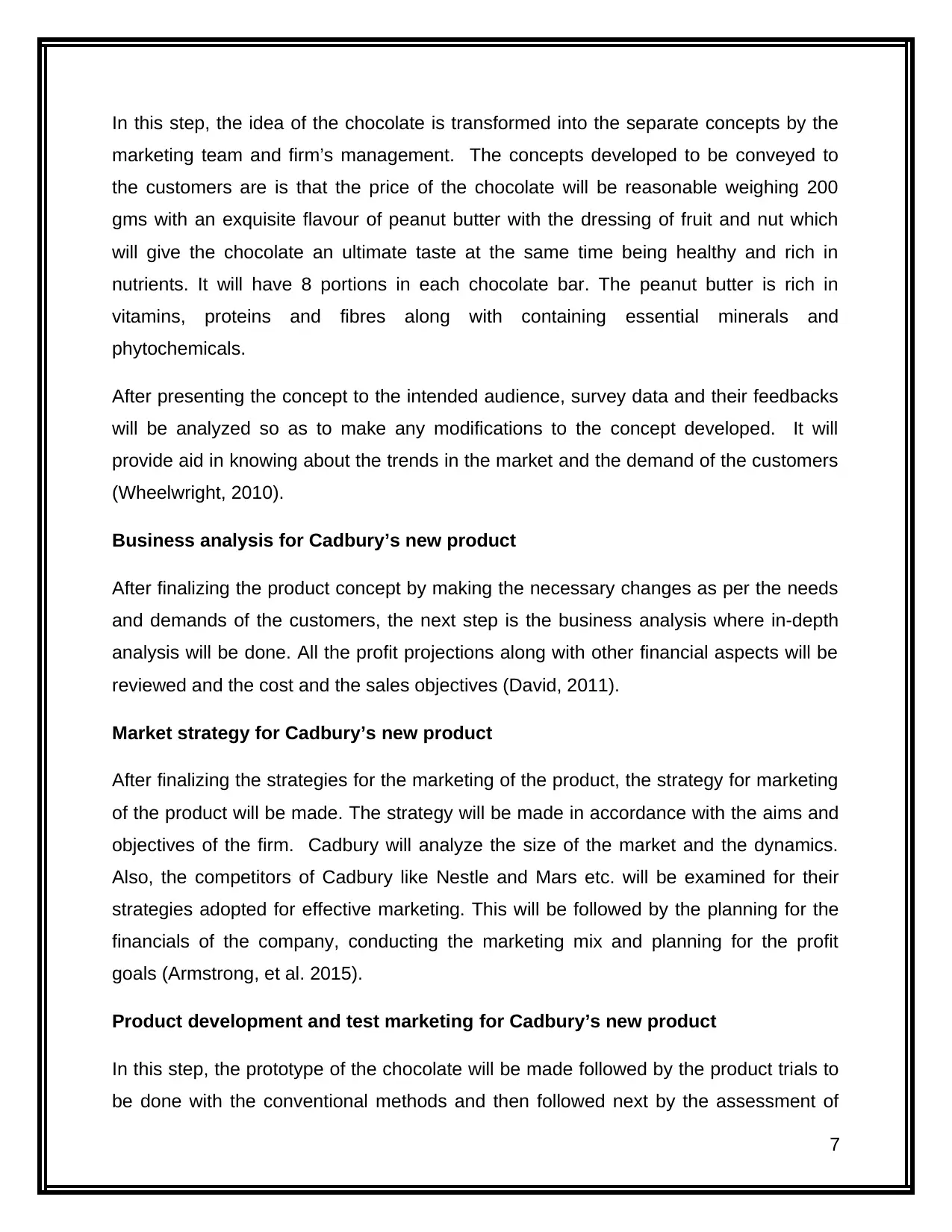
In this step, the idea of the chocolate is transformed into the separate concepts by the
marketing team and firm’s management. The concepts developed to be conveyed to
the customers are is that the price of the chocolate will be reasonable weighing 200
gms with an exquisite flavour of peanut butter with the dressing of fruit and nut which
will give the chocolate an ultimate taste at the same time being healthy and rich in
nutrients. It will have 8 portions in each chocolate bar. The peanut butter is rich in
vitamins, proteins and fibres along with containing essential minerals and
phytochemicals.
After presenting the concept to the intended audience, survey data and their feedbacks
will be analyzed so as to make any modifications to the concept developed. It will
provide aid in knowing about the trends in the market and the demand of the customers
(Wheelwright, 2010).
Business analysis for Cadbury’s new product
After finalizing the product concept by making the necessary changes as per the needs
and demands of the customers, the next step is the business analysis where in-depth
analysis will be done. All the profit projections along with other financial aspects will be
reviewed and the cost and the sales objectives (David, 2011).
Market strategy for Cadbury’s new product
After finalizing the strategies for the marketing of the product, the strategy for marketing
of the product will be made. The strategy will be made in accordance with the aims and
objectives of the firm. Cadbury will analyze the size of the market and the dynamics.
Also, the competitors of Cadbury like Nestle and Mars etc. will be examined for their
strategies adopted for effective marketing. This will be followed by the planning for the
financials of the company, conducting the marketing mix and planning for the profit
goals (Armstrong, et al. 2015).
Product development and test marketing for Cadbury’s new product
In this step, the prototype of the chocolate will be made followed by the product trials to
be done with the conventional methods and then followed next by the assessment of
7
marketing team and firm’s management. The concepts developed to be conveyed to
the customers are is that the price of the chocolate will be reasonable weighing 200
gms with an exquisite flavour of peanut butter with the dressing of fruit and nut which
will give the chocolate an ultimate taste at the same time being healthy and rich in
nutrients. It will have 8 portions in each chocolate bar. The peanut butter is rich in
vitamins, proteins and fibres along with containing essential minerals and
phytochemicals.
After presenting the concept to the intended audience, survey data and their feedbacks
will be analyzed so as to make any modifications to the concept developed. It will
provide aid in knowing about the trends in the market and the demand of the customers
(Wheelwright, 2010).
Business analysis for Cadbury’s new product
After finalizing the product concept by making the necessary changes as per the needs
and demands of the customers, the next step is the business analysis where in-depth
analysis will be done. All the profit projections along with other financial aspects will be
reviewed and the cost and the sales objectives (David, 2011).
Market strategy for Cadbury’s new product
After finalizing the strategies for the marketing of the product, the strategy for marketing
of the product will be made. The strategy will be made in accordance with the aims and
objectives of the firm. Cadbury will analyze the size of the market and the dynamics.
Also, the competitors of Cadbury like Nestle and Mars etc. will be examined for their
strategies adopted for effective marketing. This will be followed by the planning for the
financials of the company, conducting the marketing mix and planning for the profit
goals (Armstrong, et al. 2015).
Product development and test marketing for Cadbury’s new product
In this step, the prototype of the chocolate will be made followed by the product trials to
be done with the conventional methods and then followed next by the assessment of
7
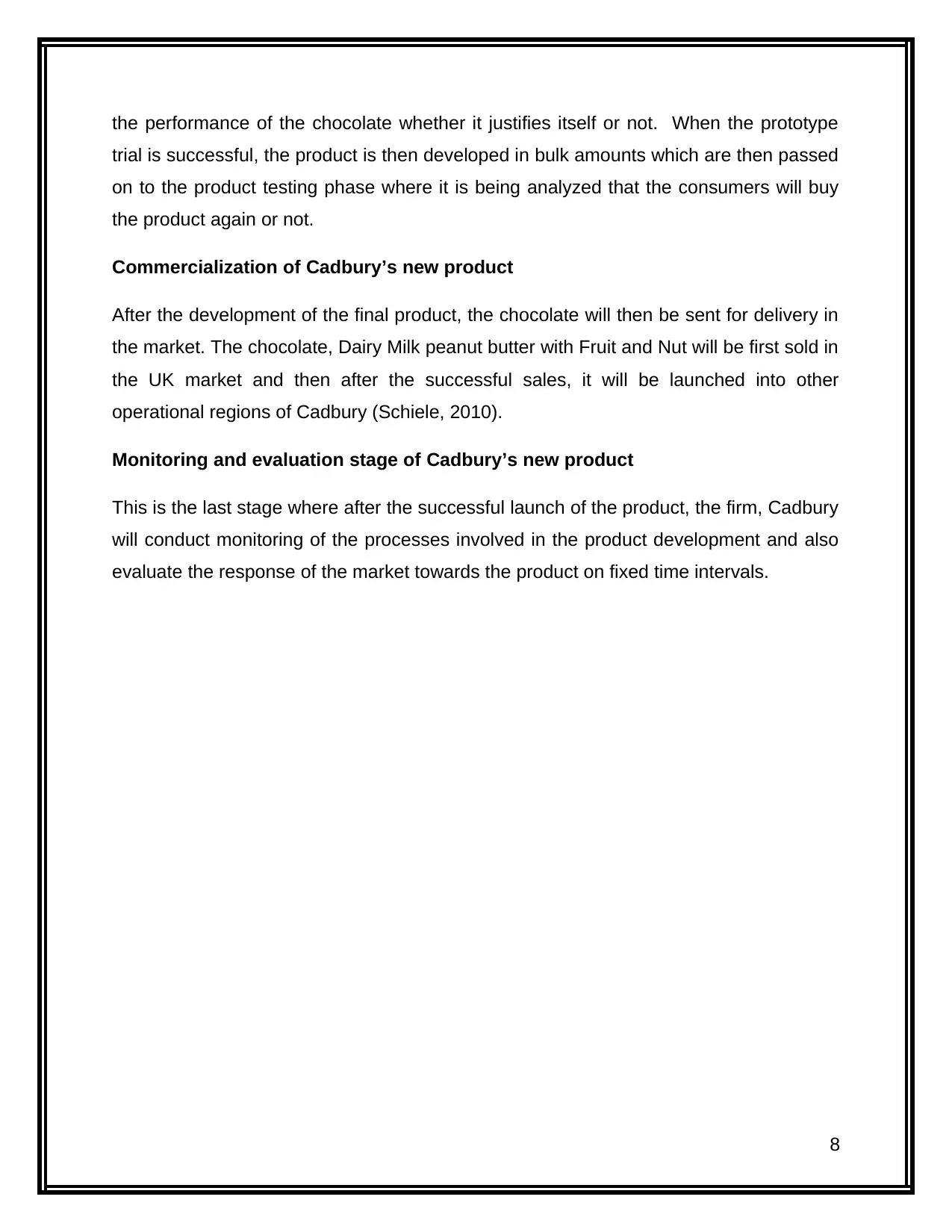
the performance of the chocolate whether it justifies itself or not. When the prototype
trial is successful, the product is then developed in bulk amounts which are then passed
on to the product testing phase where it is being analyzed that the consumers will buy
the product again or not.
Commercialization of Cadbury’s new product
After the development of the final product, the chocolate will then be sent for delivery in
the market. The chocolate, Dairy Milk peanut butter with Fruit and Nut will be first sold in
the UK market and then after the successful sales, it will be launched into other
operational regions of Cadbury (Schiele, 2010).
Monitoring and evaluation stage of Cadbury’s new product
This is the last stage where after the successful launch of the product, the firm, Cadbury
will conduct monitoring of the processes involved in the product development and also
evaluate the response of the market towards the product on fixed time intervals.
8
trial is successful, the product is then developed in bulk amounts which are then passed
on to the product testing phase where it is being analyzed that the consumers will buy
the product again or not.
Commercialization of Cadbury’s new product
After the development of the final product, the chocolate will then be sent for delivery in
the market. The chocolate, Dairy Milk peanut butter with Fruit and Nut will be first sold in
the UK market and then after the successful sales, it will be launched into other
operational regions of Cadbury (Schiele, 2010).
Monitoring and evaluation stage of Cadbury’s new product
This is the last stage where after the successful launch of the product, the firm, Cadbury
will conduct monitoring of the processes involved in the product development and also
evaluate the response of the market towards the product on fixed time intervals.
8
⊘ This is a preview!⊘
Do you want full access?
Subscribe today to unlock all pages.

Trusted by 1+ million students worldwide
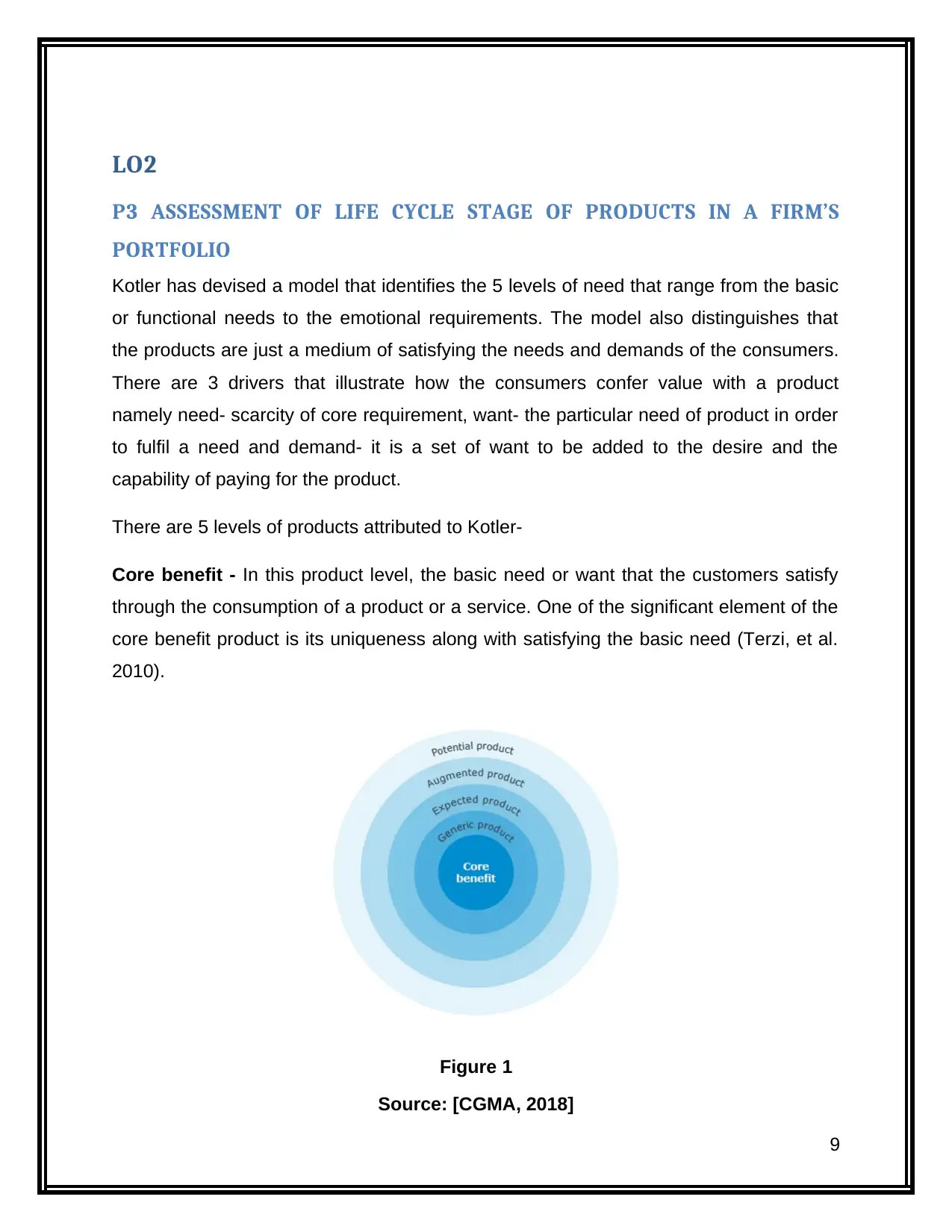
LO2
P3 ASSESSMENT OF LIFE CYCLE STAGE OF PRODUCTS IN A FIRM’S
PORTFOLIO
Kotler has devised a model that identifies the 5 levels of need that range from the basic
or functional needs to the emotional requirements. The model also distinguishes that
the products are just a medium of satisfying the needs and demands of the consumers.
There are 3 drivers that illustrate how the consumers confer value with a product
namely need- scarcity of core requirement, want- the particular need of product in order
to fulfil a need and demand- it is a set of want to be added to the desire and the
capability of paying for the product.
There are 5 levels of products attributed to Kotler-
Core benefit - In this product level, the basic need or want that the customers satisfy
through the consumption of a product or a service. One of the significant element of the
core benefit product is its uniqueness along with satisfying the basic need (Terzi, et al.
2010).
Figure 1
Source: [CGMA, 2018]
9
P3 ASSESSMENT OF LIFE CYCLE STAGE OF PRODUCTS IN A FIRM’S
PORTFOLIO
Kotler has devised a model that identifies the 5 levels of need that range from the basic
or functional needs to the emotional requirements. The model also distinguishes that
the products are just a medium of satisfying the needs and demands of the consumers.
There are 3 drivers that illustrate how the consumers confer value with a product
namely need- scarcity of core requirement, want- the particular need of product in order
to fulfil a need and demand- it is a set of want to be added to the desire and the
capability of paying for the product.
There are 5 levels of products attributed to Kotler-
Core benefit - In this product level, the basic need or want that the customers satisfy
through the consumption of a product or a service. One of the significant element of the
core benefit product is its uniqueness along with satisfying the basic need (Terzi, et al.
2010).
Figure 1
Source: [CGMA, 2018]
9
Paraphrase This Document
Need a fresh take? Get an instant paraphrase of this document with our AI Paraphraser
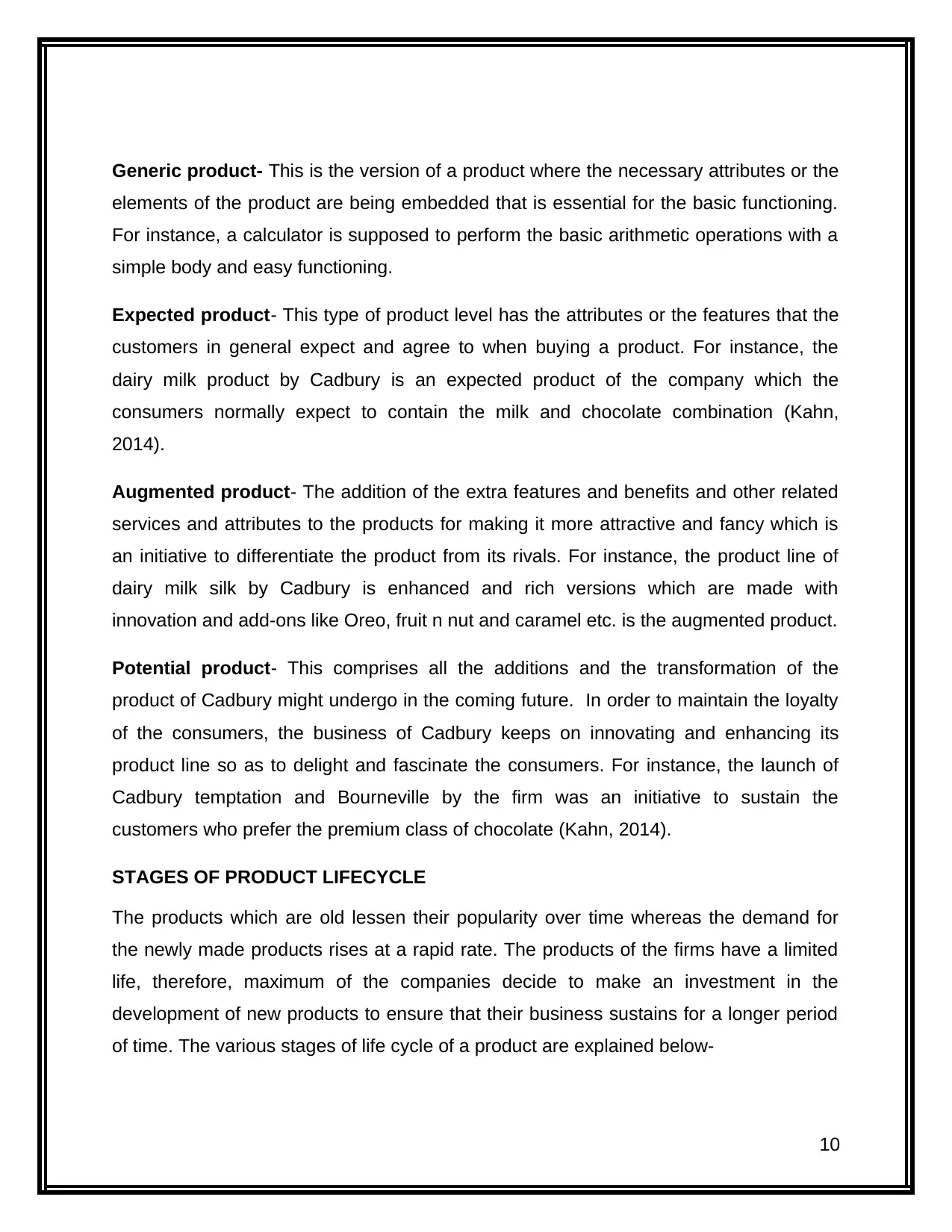
Generic product- This is the version of a product where the necessary attributes or the
elements of the product are being embedded that is essential for the basic functioning.
For instance, a calculator is supposed to perform the basic arithmetic operations with a
simple body and easy functioning.
Expected product- This type of product level has the attributes or the features that the
customers in general expect and agree to when buying a product. For instance, the
dairy milk product by Cadbury is an expected product of the company which the
consumers normally expect to contain the milk and chocolate combination (Kahn,
2014).
Augmented product- The addition of the extra features and benefits and other related
services and attributes to the products for making it more attractive and fancy which is
an initiative to differentiate the product from its rivals. For instance, the product line of
dairy milk silk by Cadbury is enhanced and rich versions which are made with
innovation and add-ons like Oreo, fruit n nut and caramel etc. is the augmented product.
Potential product- This comprises all the additions and the transformation of the
product of Cadbury might undergo in the coming future. In order to maintain the loyalty
of the consumers, the business of Cadbury keeps on innovating and enhancing its
product line so as to delight and fascinate the consumers. For instance, the launch of
Cadbury temptation and Bourneville by the firm was an initiative to sustain the
customers who prefer the premium class of chocolate (Kahn, 2014).
STAGES OF PRODUCT LIFECYCLE
The products which are old lessen their popularity over time whereas the demand for
the newly made products rises at a rapid rate. The products of the firms have a limited
life, therefore, maximum of the companies decide to make an investment in the
development of new products to ensure that their business sustains for a longer period
of time. The various stages of life cycle of a product are explained below-
10
elements of the product are being embedded that is essential for the basic functioning.
For instance, a calculator is supposed to perform the basic arithmetic operations with a
simple body and easy functioning.
Expected product- This type of product level has the attributes or the features that the
customers in general expect and agree to when buying a product. For instance, the
dairy milk product by Cadbury is an expected product of the company which the
consumers normally expect to contain the milk and chocolate combination (Kahn,
2014).
Augmented product- The addition of the extra features and benefits and other related
services and attributes to the products for making it more attractive and fancy which is
an initiative to differentiate the product from its rivals. For instance, the product line of
dairy milk silk by Cadbury is enhanced and rich versions which are made with
innovation and add-ons like Oreo, fruit n nut and caramel etc. is the augmented product.
Potential product- This comprises all the additions and the transformation of the
product of Cadbury might undergo in the coming future. In order to maintain the loyalty
of the consumers, the business of Cadbury keeps on innovating and enhancing its
product line so as to delight and fascinate the consumers. For instance, the launch of
Cadbury temptation and Bourneville by the firm was an initiative to sustain the
customers who prefer the premium class of chocolate (Kahn, 2014).
STAGES OF PRODUCT LIFECYCLE
The products which are old lessen their popularity over time whereas the demand for
the newly made products rises at a rapid rate. The products of the firms have a limited
life, therefore, maximum of the companies decide to make an investment in the
development of new products to ensure that their business sustains for a longer period
of time. The various stages of life cycle of a product are explained below-
10
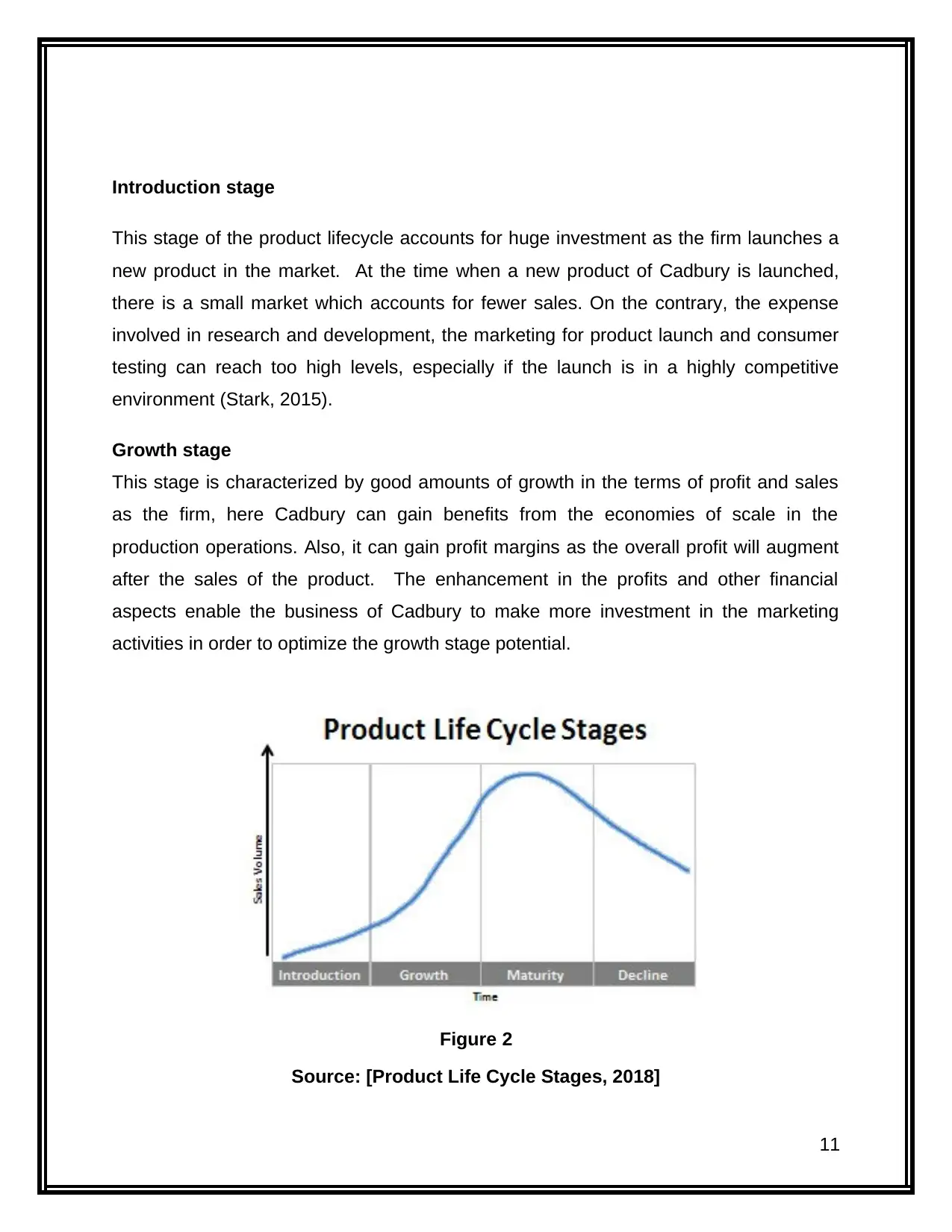
Introduction stage
This stage of the product lifecycle accounts for huge investment as the firm launches a
new product in the market. At the time when a new product of Cadbury is launched,
there is a small market which accounts for fewer sales. On the contrary, the expense
involved in research and development, the marketing for product launch and consumer
testing can reach too high levels, especially if the launch is in a highly competitive
environment (Stark, 2015).
Growth stage
This stage is characterized by good amounts of growth in the terms of profit and sales
as the firm, here Cadbury can gain benefits from the economies of scale in the
production operations. Also, it can gain profit margins as the overall profit will augment
after the sales of the product. The enhancement in the profits and other financial
aspects enable the business of Cadbury to make more investment in the marketing
activities in order to optimize the growth stage potential.
Figure 2
Source: [Product Life Cycle Stages, 2018]
11
This stage of the product lifecycle accounts for huge investment as the firm launches a
new product in the market. At the time when a new product of Cadbury is launched,
there is a small market which accounts for fewer sales. On the contrary, the expense
involved in research and development, the marketing for product launch and consumer
testing can reach too high levels, especially if the launch is in a highly competitive
environment (Stark, 2015).
Growth stage
This stage is characterized by good amounts of growth in the terms of profit and sales
as the firm, here Cadbury can gain benefits from the economies of scale in the
production operations. Also, it can gain profit margins as the overall profit will augment
after the sales of the product. The enhancement in the profits and other financial
aspects enable the business of Cadbury to make more investment in the marketing
activities in order to optimize the growth stage potential.
Figure 2
Source: [Product Life Cycle Stages, 2018]
11
⊘ This is a preview!⊘
Do you want full access?
Subscribe today to unlock all pages.

Trusted by 1+ million students worldwide
1 out of 25
Related Documents
Your All-in-One AI-Powered Toolkit for Academic Success.
+13062052269
info@desklib.com
Available 24*7 on WhatsApp / Email
![[object Object]](/_next/static/media/star-bottom.7253800d.svg)
Unlock your academic potential
Copyright © 2020–2025 A2Z Services. All Rights Reserved. Developed and managed by ZUCOL.





